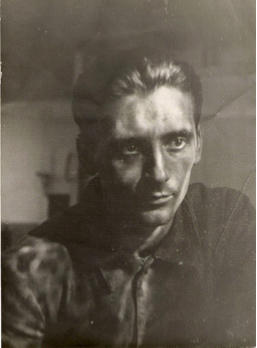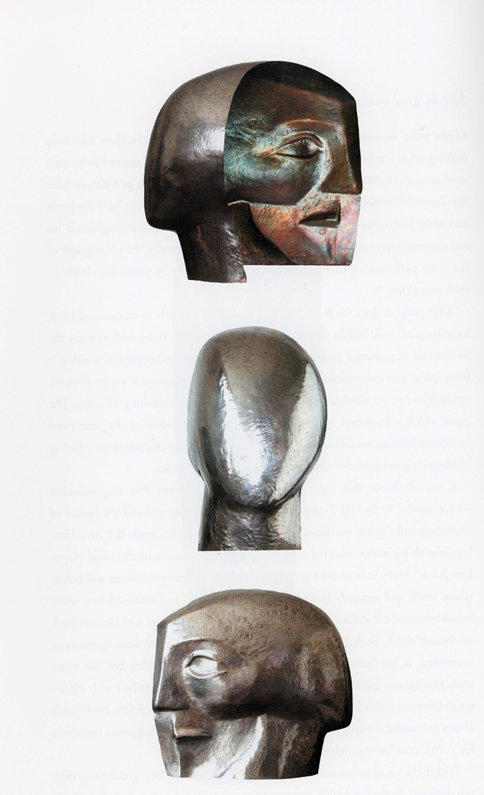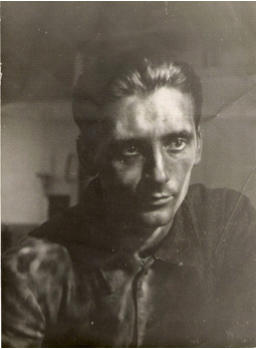Early Life
Hermann Gross was born in Lahr in Baden, Germany on
the 4th February 1904 and at the age of fourteen began his
art studies under Rudolf Yelin, a well known church
painter and stained-glassmaker in Stuttgart.
From 1919 to 1925 he attended the Württemberg Arts and
Crafts School, where he learned to become a gold- and
silversmith subsequently becoming the master pupil of
Professor Paul Haustein.
In 1925 he enrolled on a one-year course in engraving and
metal chasing at the State Academy of Fine and Applied
Arts in Berlin run by Professor Waldemar Raemisch. A year later he moved to Paris
where he worked with Robert Wlérick.
When Gross moved to Paris in 1928, he was accompanied by his partner, Hildegard
Friedrichs, author, and fashion illustrator. They shared a shed-like building in a
courtyard at 48 Avenue des Gobelins bordering Montparnasse.
Gross had a circle of friends in Paris – mostly young
people at the beginning of their artistic careers. Among
them was Jean-Louis Barrault, who became one of
France’s most distinguished actors and directors –
perhaps best remembered for his portrayal of Hamlet
and as the mime in Marcel Carné’s film Les enfants du
paradis (1944).
In 1929 Gross exhibited a metal sculpture entitled
Portrait de jeune fille repousse sur cuivre. at the Salon
d’Automne in Paris.
Suzy de Solidor
Suzy de Solidor was born in Deauville in 1900: her real name being Suzy Louise
Rocher. She changed her name to Suzy de Solidor when she moved to Paris in the
late 1920s. She was one of the first symbols of sexual emancipation in France during
the 1930s. Early in 1930, she became popular as a singer, opening a chic nightclub
called Boîte de Nuit which was one of the trendiest night spots in Paris. Suzy Solidor
did not hide her sexuality and sang songs that overtly revealed that she was gay. One
of the singer’s most famous publicity achievements was to become heralded as ‘the
most painted woman in the world’. She posed for some of the best-known artists of
the day including Jean Cocteau , Pablo Picasso , and Georges Braque. Her stipulation
for sitting was that she would be given the paintings to hang in her club. There are, in
total, around 150 paintings of Solidor. In Cagnes-sur-Mer, in the south of France,
there is a museum dedicated to her with a collection of 42 portraits all painted by
different artists. She died in 1983. It is not known whether she sat for Gross or
whether he based his work on occasional sightings of her at cabaret performances or
on the many paintings of her that would have been accessible in Paris at that time.
The Silver Head
The silver head created by Gross is of
particular interest. One quality that this
work possesses is playfulness – it is
challenging, teasing, and puzzling. This
playfulness offers both illusions and
allusions. One moment the head seems
to be one thing, the next moment it is
something else. An extraordinary
feature of the head is that from the
reverse side, the head takes on the
appearance of a Cubist painting. The
muted palette of bronze, pink, steel blue
and grey are strongly reminiscent of
certain portraits by Picasso. There can
be few examples of sculpture that
mysteriously dissolves into what
appears to be a painting.
The colours are a natural result of the
process of oxidisation. We know that
some contemporary silversmiths
deliberately seek to achieve the oxidised
effect on their jewelry.
After her husband’s death Trude Sand
insisted that the head should be kept
highly polished and one must assume that this stricture applied solely to the exterior.
What are the aesthetic consequences? Whilst the polished surface quite literally
reflects the external world, the oxidised interior invites the viewer into it. The
untreated side provides an authentic face, whilst the polished side provides an
artificial face.
The head is teasing insofar as it presents the viewer with a series of further
paradoxes. Whilst the exterior of an object is usually that aspect that gains the
viewer’s attention, here it is the interior that appears to possess more character and
meaning. What is particularly intriguing is that Gross is inviting us to see behind the
mask, something that is rarely done. It is as if a taboo has been broken. To
emphasise this feeling of gaining new insights, we are presented with a face in which
the eye is dominant and rather like the Eye of Horus – the ancient Egyptian symbol
of indestructibility.
One of the most intriguing angles from which to view the head is from the back. Or
is it the back? Gross would have been aware of the work of Constantin Brancusi, for
he was working in Paris at the same time as Gross. He would have known of
Brancusi’s minimalist representations of the human face – The Sleeping Muse. The
strongly ovate shape of the face of The Sleeping Muse intentionally suggests an egg –
a symbol of birth or new life. In discussing the nature of his work Brancusi coined
the striking aphorism that “simplicity is complexity resolved”. So, when one moves
to a position to view the ‘rear’ of the head, the intrinsic complexity of the head
magically resolves into a simple Brancusian ovoid.
So, in this single artefact – the silver head – we have allusions not only to different
artistic genres but also to symbols of considerable power – indestructability, birth,
and rebirth. These, in turn, can be interpreted as signs of resurrection and hope –
themes that Gross pursued throughout his life. But then the question may be asked:
‘How can one be so confident that Gross was trying to communicate any of these
messages? The simple answer is that we do not know. But that question rather
misses the point. What Gross has succeeded in doing is stimulating the viewer to
reflect on its meaning. The Silver Head is now in the possession of Aberdeen Art
Gallery.
Gross left Paris in 1935 and returned to Germany.







Early Life
Hermann Gross was born in Lahr in
Baden, Germany on the 4th February
1904 and at the age of fourteen began his
art studies under Rudolf Yelin, a well
known church painter and stained-
glassmaker in Stuttgart.
From 1919 to 1925 he attended the
Württemberg Arts and Crafts School,
where he learned to become a gold- and
silversmith subsequently becoming the
master pupil of Professor Paul Haustein.
In 1925 he enrolled on a one-year course
in engraving and metal chasing at the
State Academy of Fine and Applied Arts
in Berlin run by Professor Waldemar
Raemisch. A year later he moved to Paris
where he worked with Robert Wlérick.
When Gross moved to Paris in 1928, he
was accompanied by his partner,
Hildegard Friedrichs, author, and
fashion illustrator. They shared a shed-
like building in a courtyard at 48 Avenue
des Gobelins bordering Montparnasse.
Gross had a circle of friends in Paris –
mostly young people at the beginning of
their artistic careers. Among them was
Jean-Louis Barrault, who became one of
France’s most distinguished actors and
directors – perhaps best remembered for
his portrayal of Hamlet and as the mime
in Marcel Carné’s film Les enfants du
paradis (1944).
In 1929 Gross exhibited a metal sculpture
entitled Portrait de jeune fille repousse
sur cuivre. at the Salon d’Automne in
Paris.
Suzy de Solidor
Suzy de Solidor was born in Deauville in
1900: her real name being Suzy Louise
Rocher. She changed her name to Suzy
de Solidor when she moved to Paris in
the late 1920s. She was one of the first
symbols of sexual emancipation in
France during the 1930s. Early in 1930,
she became popular as a singer, opening
a chic nightclub called Boîte de Nuit
which was one of the trendiest night
spots in Paris. Suzy Solidor did not hide
her sexuality and sang songs that overtly
revealed that she was gay. One of the
singer’s most famous publicity
achievements was to become heralded as
‘the most painted woman in the world’.
She posed for some of the best-known
artists of the day including Jean Cocteau
, Pablo Picasso , and Georges Braque.
Her stipulation for sitting was that she
would be given the paintings to hang in
her club. There are, in total, around 150
paintings of Solidor. In Cagnes-sur-Mer,
in the south of France, there is a museum
dedicated to her with a collection of 42
portraits all painted by different artists.
She died in 1983. It is not known
whether she sat for Gross or whether he
based his work on occasional sightings of
her at cabaret performances or on the
many paintings of her that would have
been accessible in Paris at that time.
The Silver Head
The silver head created by Gross is of
particular interest. One quality that this
work possesses is playfulness – it is
challenging, teasing, and puzzling. This
playfulness offers both illusions and
allusions. One moment the head seems
to be one thing, the next moment it is
something else. An extraordinary
feature of the head is that from the
reverse side, the head takes on the
appearance of a Cubist painting. The
muted palette of bronze, pink, steel blue
and grey are strongly reminiscent of
certain portraits by Picasso. There can be
few examples of sculpture that
mysteriously dissolves into what appears
to be a painting.
The colours are a natural result of the
process of oxidisation. We know that
some contemporary silversmiths
deliberately seek to achieve the oxidised
effect on their jewelry.
After her husband’s death Trude Sand
insisted that the head should be kept
highly polished and one must assume
that this stricture applied solely to the
exterior. What are the aesthetic
consequences? Whilst the polished
surface quite literally reflects the external
world, the oxidised interior invites the
viewer into it. The untreated side
provides an authentic face, whilst the
polished side provides an artificial face.
The head is teasing insofar as it presents
the viewer with a series of further
paradoxes. Whilst the exterior of an
object is usually that aspect that gains the
viewer’s attention, here it is the interior
that appears to possess more character
and meaning. What is particularly
intriguing is that Gross is inviting us to
see behind the mask, something that is
rarely done. It is as if a taboo has been
broken. To emphasise this feeling of
gaining new insights, we are presented
with a face in which the eye is dominant
and rather like the Eye of Horus – the
ancient Egyptian symbol of
indestructibility.
One of the most intriguing angles from
which to view the head is from the back.
Or is it the back? Gross would have been
aware of the work of Constantin
Brancusi, for he was working in Paris at
the same time as Gross. He would have
known of Brancusi’s minimalist
representations of the human face – The
Sleeping Muse. The strongly ovate
shape of the face of The Sleeping Muse
intentionally suggests an egg – a symbol
of birth or new life. In discussing the
nature of his work Brancusi coined the
striking aphorism that “simplicity is
complexity resolved”. So, when one
moves to a position to view the ‘rear’ of
the head, the intrinsic complexity of the
head magically resolves into a simple
Brancusian ovoid.
So, in this single artefact – the silver head
– we have allusions not only to different
artistic genres but also to symbols of
considerable power – indestructability,
birth, and rebirth. These, in turn, can be
interpreted as signs of resurrection and
hope – themes that Gross pursued
throughout his life. But then the
question may be asked: ‘How can one be
so confident that Gross was trying to
communicate any of these messages?
The simple answer is that we do not
know. But that question rather misses
the point. What Gross has succeeded in
doing is stimulating the viewer to reflect
on its meaning. The Silver Head is now
in the possession of Aberdeen Art
Gallery.
Gross left Paris in 1935 and returned to
Germany.









































